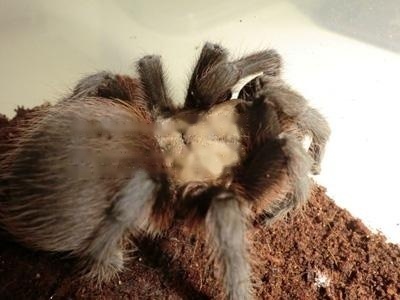
Texas Brown Tarantula
Adult body length is 13-14 cm, suitable temperature is 28-30 ℃, and suitable humidity is 65%. It is recommended to use moist peat, coconut brick and clay as the substrate. It tak
Lifetime: 15 years
Hainan tarantula (Latin name: Haplopelma hainanum) is a species of tarantula native to Hainan, Guangxi and other places in China. The species of tarantula, commonly known as "black cutworm", is a typical "earthtiger" among Asian tarantulas. Species were not identified until 1999, and were initially classified as Selenocosmia, then moved to Ornithoctonus, and finally identified by German scholars to be moved to Haplopelma in 2005.
Compared with the most famous species in the genus Haplopelma, the metallic blue from Myanmar, Thailand and other places, Hainan tarantulas are larger in size, with an adult body length of 17-18 cm. , and the body size of the tiger-patterned tarantula commonly known as "yellow ground tiger". A very aggressive and venomous species of tarantula, their color is not outstanding, pets Tarantula hobbyists keep them either because they like the ferocious species or because they like tarantulas that dig very deep, vertical burrows. Their larvae are yellow, almost exactly the same as the larvae of the tiger tarantula. The difference is that when they grow to more than 6 cm, the Hainan tarantula will gradually turn black, while the tiger tarantula is still yellow. Their larvae dare to catch food that is 2 to 3 times larger than themselves, and it can also be seen that their aggressiveness is strong, and their growth rate is relatively fast.
Hainan tarantulas are very sensitive to light, so rearing should provide a very thick substrate for them to dig deep tunnel nests. They also require high levels of humidity, and an overly dry environment puts them at risk of death from dehydration. The suitable temperature is 26-28°C, and the suitable humidity is 85%. It is recommended to use moist peat, coconut brick and clay as the substrate.
Every year, there will be many wild animals flooding the pet market in the mainland market. The low price and the sales of some irresponsible merchants make some novice people buy these animals for the first time. Not to mention that these wild individuals are affected by problems such as long-distance transportation, wrong feeding methods and parasites, and most of them are in very poor health. If they are accidentally bitten by them, it may cause unexpected results.
Compared with the most famous species in the Haplopelma genus, the metallic blue from Myanmar, Thailand and other places, the Hainan tarantula is larger in size, with an adult body length of 17-18 cm in foot span, and The tiger-patterned tarantulas, commonly known as "yellow ground tigers", are similar in size. A very aggressive and venomous species of tarantula, their color is not outstanding, pets Tarantula hobbyists keep them either because they like the ferocious species or because they like tarantulas that dig very deep, vertical burrows. Their larvae are yellow, almost exactly the same as the larvae of the tiger tarantula. The difference is that when they grow to more than 6 cm, the Hainan tarantula will gradually turn black, while the tiger tarantula is still yellow. Their larvae dare to catch food that is 2 to 3 times larger than themselves, and it can also be seen that their aggressiveness is strong, and their growth rate is relatively fast.
Hainan tarantulas are very sensitive to light, so rearing should provide a very thick substrate for them to dig deep tunnel nests. They also require high levels of humidity, and an overly dry environment puts them at risk of death from dehydration. The suitable temperature is 26-28°C, and the suitable humidity is 85%. It is recommended to use moist peat, coconut brick and clay as the substrate. [1]
Adult feet can reach up to 20 cm and are highly toxic, so they are not suitable for novice breeding. The lifespan is about 15 years.
Produced in Guangxi, Hainan and other places in China, the larger species of tarantulas produced in Asia, the adult can exceed 20 centimeters in foot span. The larvae are mainly yellow with black patterns, the larger the color will become black, the adult is completely black.
The common large individuals on the market are wild individuals, usually with more or less injuries or parasites
In addition, most of the burrowing species are timid and timid. Easily nervous, many beginners are cheap and their first attempts at raising this species mostly end in death.
The aggression of juveniles is still very small, and most of the time they just run away, but when they reach a certain size, usually more than 4-5 cm, the aggression is undoubtedly revealed.
The tarantulas of this genus are considered poisonous and need to be careful not to be bitten!